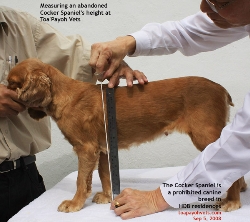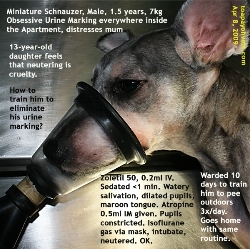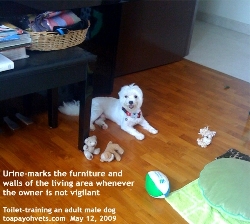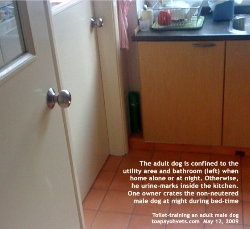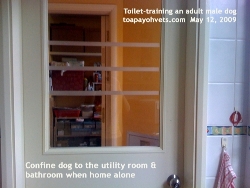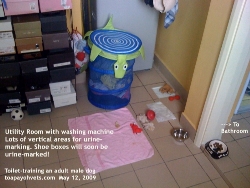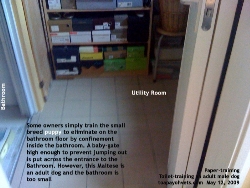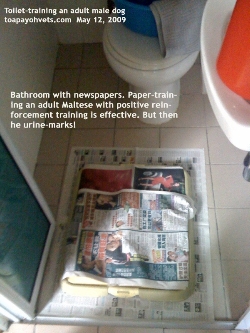Dog Owner XXX
wrote:
Dear Dr. Sing,
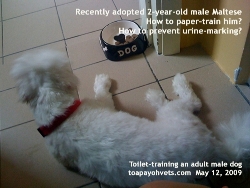
I've just adopted a 2-year old
Maltese on Saturday afternoon &
he's been with me for 2 nights.
Previous owner caged him up for
almost a year with hardly any
run-around play time because of
certain circumstances. He's kinda
paper-trained. But what I would
like to do is to get him used to
his new environment whereby he
does it in the toilet instead, but
still on paper.
Is it the right way to train him
if I were to confine him in just
the toilet area with the paper
within? Food & water to place on
another side.
Warm Regards,
XXX
|
Sent: Tuesday, April 14, 2009 To: XXX Subject: Re: Newly Adopted 2- year old Maltese Thank you for your email. As each dog behaves differently, I can only propose the following which may be suitable as your dog is mature and almost paper-trained: 1. Keep dog in toilet for 2-4 weeks but with a baby gate so that he can see you. 2. Place newspapers 100% on floor. 3. Place dog's urine smell on newspapers (use 2nd piece of newspaper with urine). 4. Observe the location where the dog pees and poops (usually away from sleeping area). 5. Reduce the papered area by 50% gradually over 1-2 weeks such that his toilet location is the newspaper. 6. Say "pee here" (on newspapers) and give food treats on success (if you are around). Persevere. 7. Change soiled papers promptly. 8. Open the baby gate but not to give the dog excessive area. Increase the area of freedom by a room and monitor. If dog goes to paper by himself, you give praise and food treats. Persevere. 9. Neutralise "accident" areas of peeing with white vinegar:water 1:3 8. Let me know how long you will take to succeed. |
April 23, 2009 & April 24,
2009 Reply in Capital Letters
Dear Dr. Sing,
Appreciate your e-mail.
Can I get your advice based on my
schedule & how things have been
for the last week.
Date of Adoption: 11th April 2009
Age: 2 year old Maltese,
Male, Not Neutered
I've been keeping DDD in the
kitchen with the newspaper on a
pee pad nearer the other end just
outside the toilet. I'm usually
away from home from 8a.m. -
7.30p.m. After which I'll let him
out to roam the house & follow me.
At night I'll put him away in the
kitchen again from 11.30p.m. -
7.15a.m. Between 7.15 - 8a.m.
before I leave house, I'll play &
cuddle him a little whilst
preparing myself for work. He's
been great so far!!! Knows how to
pee on the newspaper but because
he's left alone during the day
without any change in newspapers,
there was one time he accidentally
stepped on his poo Other times, he
mis-aimed & poo is either on the
floor right next to the pee pad,
or there's a small puddle of pee
on the floor instead. How do I
handle & prevent this situation?
HE WANTS TO AVOID THE SOILED
PAPERS WHICH ARE NOT REPLACED DUE
TO YOUR ABSENCE FROM HOME (YOU ARE
WORKING). TO YOU HE HAS
"MIS-AIMED".
SOLUTIONS:
1. A friend comes to your house to
replace the soiled papers with new
ones at e.g. lunch-time.
2. PLACE NEWSPAPERS IN 3 OR 4
SPOTS IN THE KITCHEN SO THAT HE
HAS A NEW TOILET-AREA. SOME OWNERS
DO THAT. ARE YOU DOING IT?
3. JUST COVER THE KITCHEN FLOOR
WITH NEWSPAPERS EXCEPT HIS
SLEEPING AND EATING AREA.
Another enquiry is that ever since
he's been staying with me, every
night when he's placed in the
kitchen, he whines & scratches the
kitchen door. I have yet to get a
baby gate.
DOG MAY BE SUFFERING FROM
SEPARATION ANXIETY AS HE CAN SEE
YOU. THEREFORE SCRATCHES DOOR TILL
IT IS DAMAGED. BEST YOU GET A BABY
GATE OR PUT A HIGH FENCING USING
PLAYPEN PANELS. THE PUPPY IS A
SOCIAL ANIMAL AND SHOULD BE HAPPY
JUST TO SEE YOU BEHIND THE BABY
GATE.
Things got worse last night when
my parents came back. DDD had
to re-adjust to new-comers in the
house & he refused to go into the
kitchen. Even my usual method of
throwing treats to one corner of
the kitchen to distract him to go
& stay in the kitchen didn't work
this time. I had to chase him
round the house for a while before
being able to carry him into the
kitchen.
NO OTHER WAY THAN TO CATCH HIM AND
CARRY HIM TO THE KITCHEN. HE JUST
DOES NOT WANT TO BE FENCED UP OR
LOCKED UP. THAT IS WHY HE REFUSES
TO GO TO THE KITCHEN DESPITE FOOD
TREATS ETC. HE IS GROWING UP AND
BECOMING WISER TO YOUR
'MANIPULATIONS'.
NO, I DOUBT HE WILL BE SCARED
SINCE YOU DON'T PHYSICALLY HIT HIM
LIKE SOME PUPPY OWNERS. YOU MAY
NEED TO BE MORE COMMANDING TO GAIN
HIS RESPECT. I GUESS YOU ARE MORE
A FRIEND THAN A PACK LEADER TO
HIM. SO HE BEHAVES BY NOT
LISTENING TO YOUR GENTLE FRIENDLY
TONES.
Is this the right way? Is he
scared of me unduly? Cos i dont'
want that to be the case :( :(
Please advice.
Thanx!!!!!!
Warm Regards,
XXX
From: XXX
Sent: Friday,
May 08, 2009 6:08 PM
To: 'drsing@toapayohvets.com'
Cc: 'judy@toapayohvets.com'
Subject: 459. Toilet-training
OLDER DOGS - a 2-year-old Maltese
(http://puppytoilettraining.blogspot.com/2009/04/459-toilet-training-older-dogs-2-year.html)
Dear Dr. Kong,
If you remember, I wrote to you
some time back on April 24 about
certain issues with regards to
toilet-training my 2 year old
newly adopted Maltese. You very
kindly gave me some advice! Thanx
for that ! :)
Meanwhile, there are some
developments that I wanted to
update you about & ask for further
advice.
I have also attached some images
to this e-mail so that you can see
our current kitchen that we are
placing DDD, our Maltese in.
In my previous e-mail, I indicated
that he seemed to know how to go
to pee on the newspaper that I've
placed in the kitchen toilet.
At times, there were 3-4 accidents
when we let him outside the
kitchen area into the living room
or dining areas whereby we were
not observant enough to catch him
in time to bring him to the
kitchen toilet area. But
surprisingly, there were also 2-3
other times whereby he actually
walked into the kitchen toilet
from wherever else he was in the
house to pee on the paper! So, it
seemed like things were improving.
However, in the last 4 days,
things suddenly seem to have taken
for the worse.
Previously, when we leave him in
the kitchen during our working
hours 8a.m. - 6.30p.m. & at night
when we sleep between 10.30p.m. -
6.30a.m.; he will always pee on
the kitchen toilet newspaper. As
of Tuesday , 5 May 2009, he
started peeing at 4 different
spots around the kitchen! Near the
wall ledges & even the fridge
corner. What's causing this
behaviour? Is it because he is not
fully toilet-trained or is he
doing it on purpose? He is
currently not sterilized.
Is
this causing him to "mark
territory" as some people call it?
Given this situation, does it mean
that I should go back to your
initial instructions of teaching
him from scratch?
i.e. confining him in just the
small kitchen toilet area.
As of now, during DDD's time
alone, we place him in Kitchen
areas II & III. When we are home,
we will extend the space to
Kitchen area I & then from 8p.m. -
10.30p.m., he's allowed to roam
the living room & my study room.
My parents & I have actually been
using negative reinforcement upon
advice from other dog owners.
i.e. whenever he peed in a wrong
spot, we'll bring him there, let
him smell the area & spank his
backside with our hands 2x, saying
no at the same time. But
immediately after, we'll then
guide him to the kitchen toilet
newspaper & say "pee here" & "good
boy", cuddling him a little there
at the same time.
|
Saturday,
May 9, 2009 10:32 PM From: To: XXX Thank you for your email. You are very patient with the grown up dog and take a lot of time to train him with lots of love and positive reinforcement training. Yes, your male dog is urine-marking. This is a natural behaviour. He should have been neutered at 6 months of age to prevent this behaviour. Neutering now will help but the success rate is not as high, according to some of my dog owners. POSSIBLE SOLUTIONS TO URINE MARKING PROBLEMS: 1. Confine to crate at all times for 2-4 weeks except when you are able to supervise him at all times (see paragraph 4). 2. Neuter him. 3. Allow him to come out of the crate before breakfast, lunch and dinner. But bring him outdoors to pee and urine mark. 4. Neutralise "urination" areas with white vinegar:water 1:3 with piece of cloth a few times esp. vertical areas with urine marking. 5. Allow him out of the crate when you are at home and able to supervise him closely in case he wants to urine-mark. 6. This routine gives him a chance to urine-mark outdoors e.g. tree trunks and not make your apartment smelly. It is not a good community advice from me. It is best to neuter the dog to reduce the anti-social behaviour of urine-marking although it is not a guarantee. In most cases, with my suggested routine mentioned above, the dog stops urine-marking inside the apartment. 7. So far, I have one case mentioned above. The owner of a male 1.5-year-old Miniature Schnauzer had a similar challenge as yours. Her teenaged daughter was against neutering and therefore the male dog urine-marked all over the apartment, causing considerable distress to the mum over the past year. There was a maid to clean up but the apartment started to smell. The dog started to urine-mark the carpet in addition to any furniture and vertical surfaces he could find. The modern Singapore mum does pamper the progeny and therefore the maid has to clean up every time the male Schnauzer urine-marks. He even did it on the carpet. The dog came in for vaccination and I got to know that the mum was living with this problem for the past 1 year. The teenaged daughter seemed to understand the mum's distress during our discussion. She reluctantly agreed to neutering which she considered as "cruel" and did some research on the internet as regards vasectomy and phoned me. I told her that vasectomy would not resolve this urine-marking problem. The dog was neutered. I kept the dog in Toa Payoh Vets for 10 days while she got her maid to neutralise the apartment. At Toa Payoh Vets, we took the dog outdoors 3 times a day, after meals. He controlled his bladder till he was outdoors. The owner continued the same routine of outdoor exercise 3x/day and confinement in a crate (or balcony) when not supervised. For the past month, there has been no urine-marking inside the apartment. The mum was so happy. It is very difficult to remove urine smells from carpets and that was what was distressing her so much. I hope the info helps. |
May 11, 2009
XXX wrote:
 TOA
PAYOH VETS
TOA
PAYOH VETS